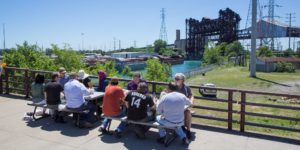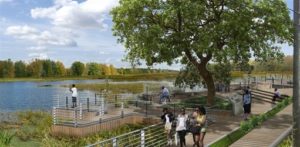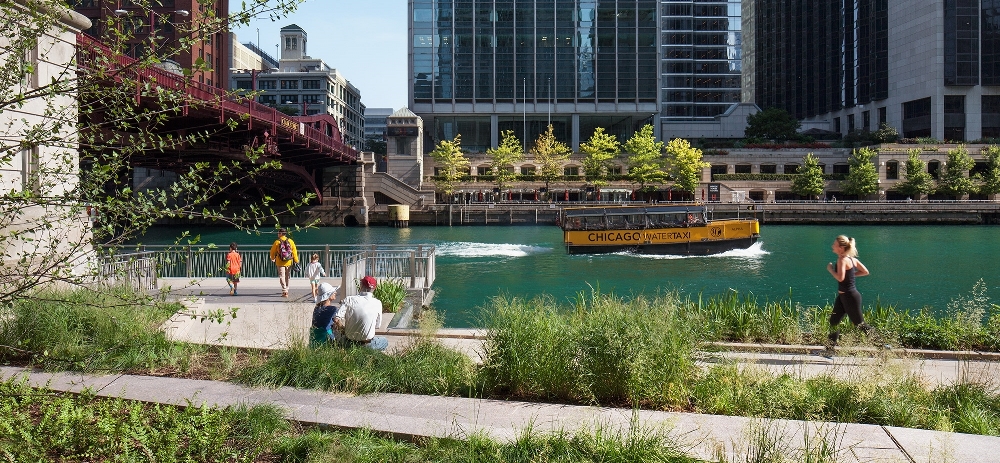The Chicago River is a system of rivers and canals with a combined length of 156 miles (251 km) that runs through the city of Chicago, Illinois.
Though not especially long, the river is notable for being a major reason why Chicago became an important location. The related Chicago Portage was a key link between the Great Lakes and the Mississippi Valley waterways, and eventually the Gulf of Mexico.
 The River is also noteworthy for its natural and man-made history. The vast quantities of raw sewage and factory waste being dumped into the Chicago River ended up in Lake Michigan, which is the city’s source of drinking water. A precipitous decline in public health ensued, mostly from waterborne diseases like typhoid and cholera.
The River is also noteworthy for its natural and man-made history. The vast quantities of raw sewage and factory waste being dumped into the Chicago River ended up in Lake Michigan, which is the city’s source of drinking water. A precipitous decline in public health ensued, mostly from waterborne diseases like typhoid and cholera.
The Illinois General Assembly (IGA) then decided in 1887 that they would rather poison people in other states, rather than their own voters. They reversed the flow of the Chicago River through civil engineering by taking water from Lake Michigan and discharging it into the Mississippi River watershed. They did this by reversing the flow of the Main Stem and South Branch of the river using a series of canal locks, thus increasing the river’s flow from Lake Michigan.
In 1999, this “solution” honored as a Civil Engineering Monument of the Millennium by the American Society of Civil Engineers (ASCE). These are the same folks who honored the practice of digging a hole, throwing garbage in it, and covering it up (AKA “sanitary landfills”) as one of civil engineering’s greatest inventions.
But by 1930, after legal complaints from those poisoned cities downstream, the U.S. Supreme Court ordered Chicago to address the pollution problem. Since then, efforts have been ongoing to clean up the waterway.
So, the Chicago River has traditionally had two main functions: discharging ships, and shipping discharge. It’s traditionally been more of an open sewer than a river. So, would it surprise you to know that city leaders want you to swim in it? Not today mind you, but in the not-too-far-distant future. Those decades of cleanup efforts, powered in large part by the Clean Water Act of 1972, and enforced by the U.S. Environmental Protection Agency, are starting to pay off.

Rendering of restored river by Sasaki.
In 2015, Mayor Rahm Emanuel and the Metropolitan Planning Council announced the Great Rivers Chicago effort, as reported here and here in REVITALIZATION.
This is a city-wide visioning process, designed to develop a long-term plan to clean up and reintegrate into city life the three rivers of the Chicago system: the Chicago, Calumet, and Des Plaines Rivers.
All this activity comes together at Great Rivers Chicago. Here’s their vision: “Our rivers will be inviting: Enhancements to infrastructure, information and programming will make our rivers more intuitive, meaningful and exciting places to be, drawing more people for recreation, work and relaxation.”
They are achieving that vision via: “Improved cleanliness, safety and neighborhood linkages will lay the groundwork for creating more welcoming rivers and riverfronts. Better wayfinding and interpretative signage will convey the breadth of the rivers’ role in shaping Chicago’s past and future, while making the system easy to navigate. City, neighborhood and civic leaders will collaborate to design new access points, amenities, entertainment and activities for residents and tourists of all ages and abilities.”
In 2017, making riverfront activation a reality was the topic of two workshops led by Great Rivers Chicago. They were called Ideas to Action: Turning your riverfront into a neighborhood destination. They were sponsored by CKL Engineers, and were hosted at the Chicago Maritime Museum, and both were sold-out.
They brought together 140 local residents, community organization leaders, government agencies and environmental groups to talk about their ideas for improving their stretch of river (including the Calumet system, Chicago and Des Plaines). Chicago rivers and riverfronts badly need physical improvements, amenities, stewardship, habitat, businesses, and neighborhood programming like public art, recreation, and education.
Local residents and entrepreneurs are the ones making a lot of this activation work happen. Some aren’t waiting for swimming conditions, and are already out there in their canoes and kayaks. It’s a good example of the 3Re Strategy: repurposing the river from sewer to a recreational asset, which involves renewing its health and reconnecting it to the city.
Photos courtesy of Great Rivers Chicago unless otherwise credited.

